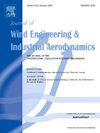基于 MOST 高斯唤醒模型和深度学习方法的唤醒预测框架
IF 4.9
2区 工程技术
Q1 ENGINEERING, CIVIL
Journal of Wind Engineering and Industrial Aerodynamics
Pub Date : 2024-11-15
DOI:10.1016/j.jweia.2024.105952
引用次数: 0
摘要
随着风能的快速发展,准确预测风力涡轮机后方的尾流速度分布对于风电场的负荷评估和协调控制至关重要。然而,现有的尾流模型仍无法准确预测实际风电场中复杂多变的流入特性和风机运行状态。为解决这一问题,本文提出了一种基于莫宁-奥布霍夫相似理论(MOST)的高斯唤醒模型与深度学习方法相结合的唤醒预测框架。在该框架中,改进了 MOST 高斯尾流模型以考虑偏航修正,并采用一维卷积神经网络-双向长短期记忆(1DCNN-BiLSTM)深度学习模型,以流入特征和风机运行状态为输入,动态校准尾流扩展率参数。实际风电场案例研究的验证表明,所提出的框架在 Penmanshiel 风电场实现了 95.35% 的风速预测精度和 84.17% 的功率预测精度,在 La Haute Born 风电场实现了 97.12% 的风速预测精度和 87.59% 的功率预测精度。该框架的高预测精度为未来风电场的负荷评估和协调控制提供了可靠依据,并为优化风电场设计和运行策略提供了新思路。本文章由计算机程序翻译,如有差异,请以英文原文为准。
A wake prediction framework based on the MOST Gaussian wake model and a deep learning approach
With the rapid development of wind energy, accurately predicting the wake speed distribution behind wind turbines is crucial for load assessment and coordinated control of wind farms. However, existing wake models still fall short in accurately predicting under the complex and variable inflow characteristics and turbine operating states in actual wind farms. To address this issue, this paper proposes a wake prediction framework that combines the Gaussian wake model based on Monin-Obukhov Similarity Theory (MOST) and deep learning approach. In this framework, the MOST Gaussian wake model is improved to account for yaw correction, and the one-dimensional convolutional neural network-bidirectional long-short-term memory (1DCNN-BiLSTM) deep learning model is employed to dynamically calibrate the wake expansion rate parameters using both inflow characteristics and turbine operating states as inputs. Validation with actual wind farm case studies shows the proposed framework achieves 95.35% wind speed prediction accuracy and 84.17% power accuracy at Penmanshiel wind farm, and 97.12% wind speed accuracy and 87.59% power accuracy at La Haute Born wind farm. The high prediction accuracy of this framework provides a reliable basis for future load assessment and coordinated control of wind farms and offers new ideas for optimizing wind farm design and operation strategies.
求助全文
通过发布文献求助,成功后即可免费获取论文全文。
去求助
来源期刊
CiteScore
8.90
自引率
22.90%
发文量
306
审稿时长
4.4 months
期刊介绍:
The objective of the journal is to provide a means for the publication and interchange of information, on an international basis, on all those aspects of wind engineering that are included in the activities of the International Association for Wind Engineering http://www.iawe.org/. These are: social and economic impact of wind effects; wind characteristics and structure, local wind environments, wind loads and structural response, diffusion, pollutant dispersion and matter transport, wind effects on building heat loss and ventilation, wind effects on transport systems, aerodynamic aspects of wind energy generation, and codification of wind effects.
Papers on these subjects describing full-scale measurements, wind-tunnel simulation studies, computational or theoretical methods are published, as well as papers dealing with the development of techniques and apparatus for wind engineering experiments.

 求助内容:
求助内容: 应助结果提醒方式:
应助结果提醒方式:


